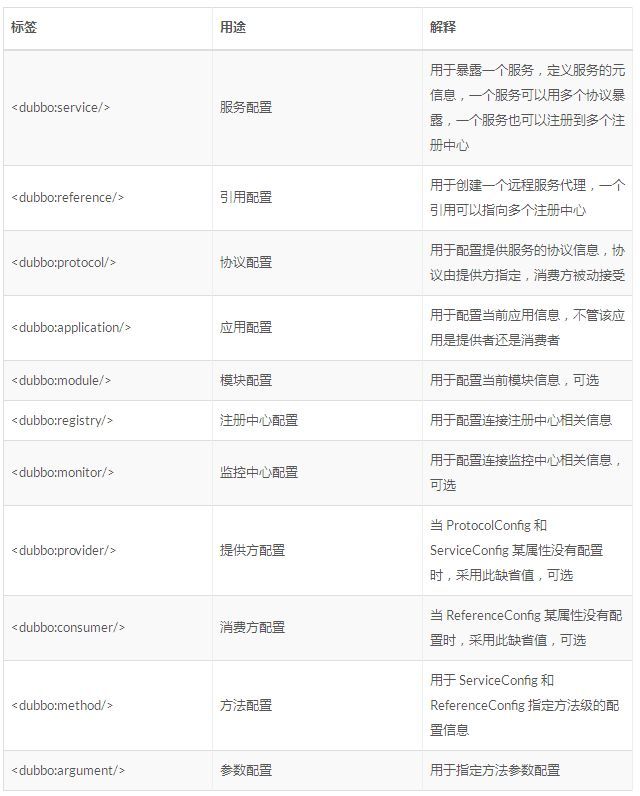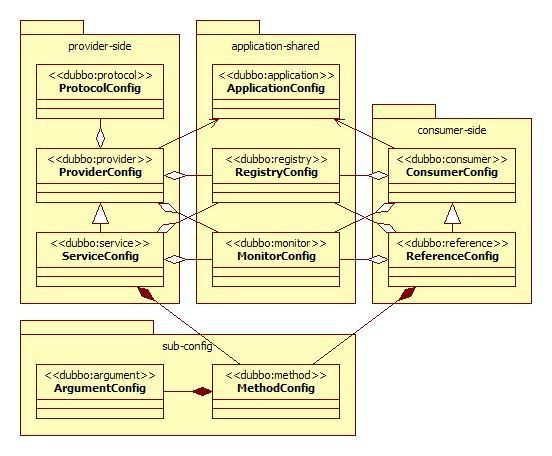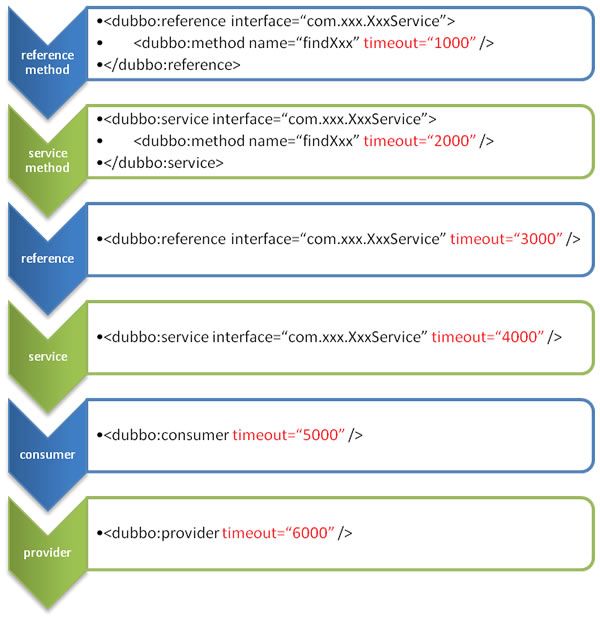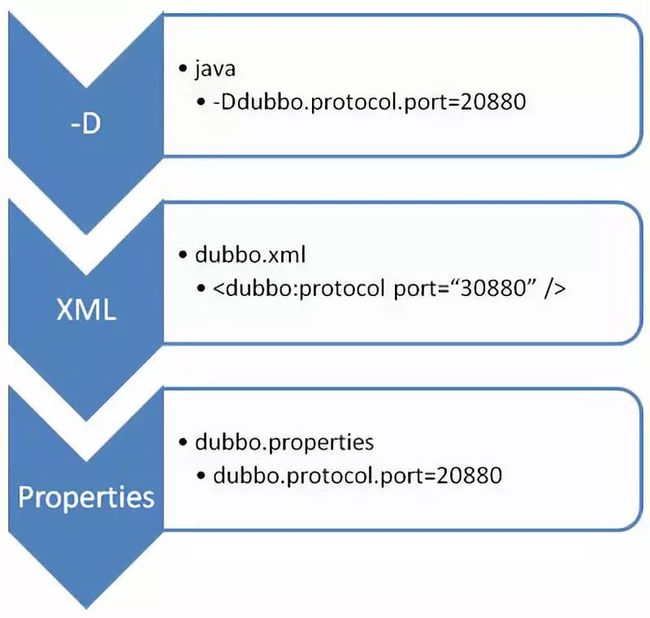Dubbo基本用法-Dubbo Provider配置
Dubbo基本用法
本章节主要讲述如何配置dubbo,按照配置方式上分,可以分为:XML配置,properties方式配置,注解方式配置,API调用方式配置。
按照功能角度进行划分,可以分为Dubbo Provider和Dubbo Consumer。接下来章节中,分别对dubbo provider和Dubbo consumer进行讲解。
Dubbo Provider配置
Provider 配置详解
配置Dubbo Provider有4种方式:XML配置,properties方式配置,API调用方式配置,注解方式配置。
XML配置
最简单的配置的样例:
上面样例中,注意下dubbo schema的写法:
支持的配置标签
配置之间关系图
配置项详解
用于指定应用名,这里需要保证应用名唯一,这个应用名在后续的console admin中可以在列表中显示,方便管理。
注册中心配置,和服务发现的具体机制有关系。可以是zookeeper地质,也可以eureka地质。上面这个是广播地址,在本地服务调用的测试过程中非常方便。
这里是传输的协议和默认端口,一般不需要更改。
接下来重点讲解下
| 属性名 | 说明 |
| ——– | —– |
| version | 版本号 |
| scope | 服务可见性, 值为:local 或者 remote,默认为remote |
| actives | 最大的激活的请求数 |
| async | 方法调用是否异步,默认为false |
| cache | 服务缓存,可选值:lru/threadlocal/jcache |
| callbacks | callback实例的限制 |
| generic | 泛化调用,可以绕过 |
| class | Service的实现的类名 |
| connections | 这个服务里的连接数 |
| delay | 发布服务延迟的毫秒数 |
| executes | 服务执行的请求上限 |
| retries | 超时重试次数 |
| timeout | 调用超时时间 |
其他配置属性请参考xsd:http://dubbo.apache.org/schema/dubbo/dubbo.xsd
其他属性,可以参考上面的xsd。
配置的覆盖关系
配置的覆盖关系图
这里的覆盖关系包含了Provider和Consumer两端的配置,如果对consumer有疑问,可以参考后一章节的consumer章节之后再来理解。
dubbo.properties方式配置
如果公共配置很简单,没有多注册中心,多协议等情况,或者想多个 Spring 容器想共享配置,可以使用 dubbo.properties 作为缺省配置。
Dubbo 将自动加载 classpath 根目录下的 dubbo.properties,可以通过JVM启动参数 -Ddubbo.properties.file=xxx.properties 改变缺省配置位置。
dubbo.properties配置样例
# 应用名
dubbo.application.name=dubbodemo-provider
# 注册中心地址
dubbo.registry.address=zookeeper://localhost:2181
# 广播的注册中心样例
#dubbo.registry.address=multicast://224.5.6.7:1234
# 调用协议地址
dubbo.protocol.name=dubbo
dubbo.protocol.port=28080
映射规则
将 XML 配置的标签名,加属性名,用点分隔,多个属性拆成多行
比如:dubbo.application.name=foo等价于
比如:dubbo.registry.address=10.20.153.10:9090等价于
如果 XML 有多行同名标签配置,可用 id 号区分,如果没有 id 号将对所有同名标签生效
比如:dubbo.protocol.rmi.port=1234等价于
比如:dubbo.registry.china.address=10.20.153.10:9090等价于
覆盖策略
JVM 启动 -D 参数优先,这样可以使用户在部署和启动时进行参数重写,比如在启动时需改变协议的端口。
XML 次之,如果在 XML 中有配置,则 dubbo.properties 中的相应配置项无效。
Properties 最后,相当于缺省值,只有 XML 没有配置时,dubbo.properties 的相应配置项才会生效,通常用于共享公共配置,比如应用名。
注意:
1.如果 classpath 根目录下存在多个 dubbo.properties,比如多个 jar 包中有 dubbo.properties,Dubbo 会任意加载,并打印 Error 日志,后续可能改为抛异常。
2.协议的 id 没配时,缺省使用协议名作为 id
annotation
Service注解暴露服务
import com.alibaba.dubbo.config.annotation.Service;
@Service(timeout = 5000)
public class AnnotateServiceImpl implements AnnotateService {
// ...
}
javaconfig形式配置公共模块
@Configuration
public class DubboConfiguration {
@Bean
public ApplicationConfig applicationConfig() {
ApplicationConfig applicationConfig = new ApplicationConfig();
applicationConfig.setName("provider-test");
return applicationConfig;
}
@Bean
public RegistryConfig registryConfig() {
RegistryConfig registryConfig = new RegistryConfig();
registryConfig.setAddress("zookeeper://127.0.0.1:2181");
registryConfig.setClient("curator");
return registryConfig;
}
}
这种方式的配置和前面用xml配置的方式是一样的效果。
指定dubbo扫描路径
@SpringBootApplication
@DubboComponentScan(basePackages = "com.alibaba.dubbo.test.service.impl")
public class ProviderTestApp {
// ...
}
或者使用spring bean xml配置方式:
api直接触发
import com.alibaba.dubbo.rpc.config.ApplicationConfig;
import com.alibaba.dubbo.rpc.config.RegistryConfig;
import com.alibaba.dubbo.rpc.config.ProviderConfig;
import com.alibaba.dubbo.rpc.config.ServiceConfig;
import com.xxx.XxxService;
import com.xxx.XxxServiceImpl;
// 服务实现
XxxService xxxService = new XxxServiceImpl();
// 当前应用配置
ApplicationConfig application = new ApplicationConfig();
application.setName("xxx");
// 连接注册中心配置
RegistryConfig registry = new RegistryConfig();
registry.setAddress("10.20.130.230:9090");
registry.setUsername("aaa");
registry.setPassword("bbb");
// 服务提供者协议配置
ProtocolConfig protocol = new ProtocolConfig();
protocol.setName("dubbo");
protocol.setPort(12345);
protocol.setThreads(200);
// 注意:ServiceConfig为重对象,内部封装了与注册中心的连接,以及开启服务端口
// 服务提供者暴露服务配置
ServiceConfig service = new ServiceConfig(); // 此实例很重,封装了与注册中心的连接,请自行缓存,否则可能造成内存和连接泄漏
service.setApplication(application);
service.setRegistry(registry); // 多个注册中心可以用setRegistries()
service.setProtocol(protocol); // 多个协议可以用setProtocols()
service.setInterface(XxxService.class);
service.setRef(xxxService);
service.setVersion("1.0.0");
// 暴露及注册服务
service.export();
一般在spring应用中,不推荐使用这种方式。 具体的含义这里不做解释,可以通过github查看源码。
Provider 接口和实现
上面章节更多从配置角度出发,接下来通过一个完整的例子,来讲解下dubbo provider的完整使用。
这个例子中只有一个服务UserReadService,有一个方法 getUserById。 需要将这个服务通过Dubbo暴露给远程的服务。具体的步骤如下:
1.创建工程
如果本来已经有工程,可以忽略。创建一个spring boot工程,可以通过 https://start.spring.io/ 创建。
2.定义接口
定义接口:UserReadService
public interface UserReadService{
public User getUserById(Long userId);
}
这个接口一般来说会放到独立的jar包里,作为client包。 其他应用要消费这个服务的时候,一般来说需要应用引用这个client包。(除了泛化调用)
3.实现接口
实现UserReadService, 当前实现部署在Provider的应用中。
public UserReadServiceImpl implements UserReadService{
public User getUserById(Long userId){
return xxx;
}
}
4.Dubbo配置
在此我向大家推荐一个架构学习交流群。交流学习群号:478030634 里面会分享一些资深架构师录制的视频录像:有Spring,MyBatis,Netty源码分析,高并发、高性能、分布式、微服务架构的原理,JVM性能优化、分布式架构等这些成为架构师必备的知识体系。还能领取免费的学习资源,目前受益良多
![]()




